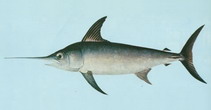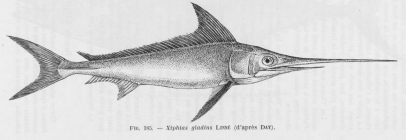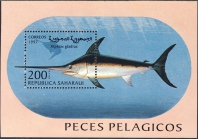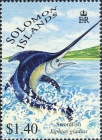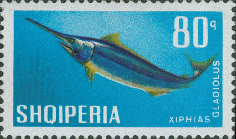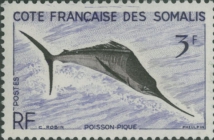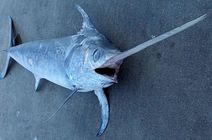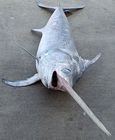WoRMS taxon details
Xiphias gladius Linnaeus, 1758
127094 (urn:lsid:marinespecies.org:taxname:127094)
accepted
Species
Phaethonichthys tuberculatus Nichols, 1923 · unaccepted
Tetrapterus imperator (Bloch & Schneider, 1801) · unaccepted
Xiphasia gladius (Linnaeus, 1758) · unaccepted (misspelling)
Xiphias estara Phillipps, 1932 · unaccepted
Xiphias gladius estara Phillipps, 1932 · unaccepted
Xiphias imperator Bloch & Schneider, 1801 · unaccepted
Xiphias rondeletii Leach, 1814 · unaccepted (synonym)
Xiphias rondeletti Leach, 1814 · unaccepted (synonym)
Xiphias thermaicus Serbetis, 1951 · unaccepted
Xyphias gladius Linnaeus, 1758 · unaccepted > misspelling - incorrect subsequent spelling
- Subspecies Xiphias gladius estara Phillipps, 1932 accepted as Xiphias gladius Linnaeus, 1758
marine, brackish, fresh, terrestrial
Linnaeus, C. (1758). Systema Naturae per regna tria naturae, secundum classes, ordines, genera, species, cum characteribus, differentiis, synonymis, locis. [The system of nature through the three kingdoms of nature, according to classes, orders, genera, species, with characters, differences, synonyms, places.]. <em>Impensis Direct. Laurentii Salvii. Holmiae [Stockholm].</em> 1(10) [iii], 824 p., available online at https://biodiversitylibrary.org/page/726886
page(s): 248 [details] Available for editors [request]
[request]
page(s): 248 [details] Available for editors
Description Occurs at a temperature range of 5° to 27°C, generally above the thermocline but may descend to depths of 800 m (Ref....
Distribution Bonne Bay, over the Grand Bank along the offing of Cape Breton and in to the southern Gulf of St Lawrence and along the...
Description Occurs at a temperature range of 5° to 27°C, generally above the thermocline but may descend to depths of 800 m (Ref. 9354), but prefers temperatures of 18°C to 22°C (Ref. 9987). Primarily a warm-water species. Although oceanic, sometimes found in coastal waters (Ref. 9354). Its migrations consist of movements toward temperate or cold waters for feeding in summer and back to warm waters in autumn for spawning and overwintering. Lives a solitary life upon the high seas. Larvae are frequently encountered at temperatures above 24 °C (Ref. 9702). Adults are opportunistic feeders, known to forage for their food from the surface to the bottom over a wide depth range (Ref. 9702). Uses its sword to kill its prey (Ref. 9354). Feeds mainly on fishes but also on crustaceans and squids (Ref. 9354). Also caught with harpoons, drift gill nets and set nets by commercial fisheries and by trolling in sports fishing (Ref. 9702). A good food fish, it is marketed fresh or frozen, and can be made into sashimi, teriyaki or fillets (Ref. 9354). Large individuals may accumulate large percentages of mercury in its flesh (Ref. 9354). [details]
Distribution Bonne Bay, over the Grand Bank along the offing of Cape Breton and in to the southern Gulf of St Lawrence and along the...
Distribution Bonne Bay, over the Grand Bank along the offing of Cape Breton and in to the southern Gulf of St Lawrence and along the outer coast of Nova Scotia, southward along the coast of the United States; into Argentina in the South Atlantic [details]
Froese, R. and D. Pauly. Editors. (2025). FishBase. Xiphias gladius Linnaeus, 1758. Accessed through: World Register of Marine Species at: https://www.marinespecies.org/aphia.php?p=taxdetails&id=127094 on 2025-04-01
Date
action
by
![]() The webpage text is licensed under a Creative Commons
Attribution-Noncommercial 4.0 License
The webpage text is licensed under a Creative Commons
Attribution-Noncommercial 4.0 License
Nomenclature
original description
Linnaeus, C. (1758). Systema Naturae per regna tria naturae, secundum classes, ordines, genera, species, cum characteribus, differentiis, synonymis, locis. [The system of nature through the three kingdoms of nature, according to classes, orders, genera, species, with characters, differences, synonyms, places.]. <em>Impensis Direct. Laurentii Salvii. Holmiae [Stockholm].</em> 1(10) [iii], 824 p., available online at https://biodiversitylibrary.org/page/726886
page(s): 248 [details] Available for editors [request]
[request]
original description (of Xiphias rondeletii Leach, 1814) Leach, W. E. ; Nodder, R. P. (1814). The zoological miscellany; being descriptions of new, or interesting animals. <em>The zoological miscellany.</em> E. Nodder & Son, London. v. 1-3: 1-144, 1-160, 1-151, 149 pls. [Pls. 1-50 (v. 1), 51-120 (v. 2), 121-149 (v. 3)].
page(s): 58, Pl. 2 (fig. 1) [details]
original description (of Xiphias imperator Bloch & Schneider, 1801) Bloch, M.E.; Schneider, J.G. (1801). M.E. Blochii, Systema Ichthyologiae iconibus cx illustratum. Post obitum auctoris opus inchoatum absolvit, correxit, interpolavit Jo. <em>Gottlob Schneider, Saxo. Berolini. Sumtibus Auctoris Impressum et Bibliopolio Sanderiano Commissum.</em> Pp i-lx + 1-584, Pls. 1-110., available online at https://www.biodiversitylibrary.org/bibliography/5750#/summary
page(s): 93, Pl. 21 [details]
original description (of Xiphias thermaicus Serbetis, 1951) Serbetis, K. (1951). [A new form of Xiphias, Xiphias thermaïcus n. sp.]. <em>Praktika tes Akademias Athenon.</em> v. 22 (for 6 Nov. 1947): 269-273. [In Greek, Italian summary.]. [details]
basis of record van der Land, J.; Costello, M.J.; Zavodnik, D.; Santos, R.S.; Porteiro, F.M.; Bailly, N.; Eschmeyer, W.N.; Froese, R. (2001). Pisces, <B><I>in</I></B>: Costello, M.J. <i>et al.</i> (Ed.) (2001). <i>European register of marine species: a check-list of the marine species in Europe and a bibliography of guides to their identification. Collection Patrimoines Naturels,</i> 50: pp. 357-374 (look up in IMIS) [details]
page(s): 248 [details] Available for editors
original description (of Xiphias rondeletii Leach, 1814) Leach, W. E. ; Nodder, R. P. (1814). The zoological miscellany; being descriptions of new, or interesting animals. <em>The zoological miscellany.</em> E. Nodder & Son, London. v. 1-3: 1-144, 1-160, 1-151, 149 pls. [Pls. 1-50 (v. 1), 51-120 (v. 2), 121-149 (v. 3)].
page(s): 58, Pl. 2 (fig. 1) [details]
original description (of Xiphias imperator Bloch & Schneider, 1801) Bloch, M.E.; Schneider, J.G. (1801). M.E. Blochii, Systema Ichthyologiae iconibus cx illustratum. Post obitum auctoris opus inchoatum absolvit, correxit, interpolavit Jo. <em>Gottlob Schneider, Saxo. Berolini. Sumtibus Auctoris Impressum et Bibliopolio Sanderiano Commissum.</em> Pp i-lx + 1-584, Pls. 1-110., available online at https://www.biodiversitylibrary.org/bibliography/5750#/summary
page(s): 93, Pl. 21 [details]
original description (of Xiphias thermaicus Serbetis, 1951) Serbetis, K. (1951). [A new form of Xiphias, Xiphias thermaïcus n. sp.]. <em>Praktika tes Akademias Athenon.</em> v. 22 (for 6 Nov. 1947): 269-273. [In Greek, Italian summary.]. [details]
basis of record van der Land, J.; Costello, M.J.; Zavodnik, D.; Santos, R.S.; Porteiro, F.M.; Bailly, N.; Eschmeyer, W.N.; Froese, R. (2001). Pisces, <B><I>in</I></B>: Costello, M.J. <i>et al.</i> (Ed.) (2001). <i>European register of marine species: a check-list of the marine species in Europe and a bibliography of guides to their identification. Collection Patrimoines Naturels,</i> 50: pp. 357-374 (look up in IMIS) [details]
Ecology
ecology source
Looby, A.; Erbe, C.; Bravo, S.; Cox, K.; Davies, H. L.; Di Iorio, L.; Jézéquel, Y.; Juanes, F.; Martin, C. W.; Mooney, T. A.; Radford, C.; Reynolds, L. K.; Rice, A. N.; Riera, A.; Rountree, R.; Spriel, B.; Stanley, J.; Vela, S.; Parsons, M. J. G. (2023). Global inventory of species categorized by known underwater sonifery. <em>Scientific Data.</em> 10(1). (look up in IMIS), available online at https://doi.org/10.1038/s41597-023-02745-4 [details] 
Other
context source (Deepsea)
Intergovernmental Oceanographic Commission (IOC) of UNESCO. The Ocean Biogeographic Information System (OBIS), available online at http://www.iobis.org/ [details]
context source (Schelde) Maris, T., O. Beauchard, S. Van Damme, E. Van den Bergh, S. Wijnhoven & P. Meire. (2013). Referentiematrices en Ecotoopoppervlaktes Annex bij de Evaluatiemethodiek Schelde-estuarium Studie naar “Ecotoopoppervlaktes en intactness index”. [Reference matrices and Ecotope areas Annex to the Evaluation methodology Scheldt estuary Study on “Ecotope areas and intactness index”. <em>Monitor Taskforce Publication Series, 2013-01. NIOZ: Yerseke.</em> 35 pp. (look up in IMIS) [details]
context source (Bermuda) Smith-Vaniz, W. F.; Collette, B. B.; Luckhurst, B. E (1999). Fishes of Bermuda: History, zoogeography, annotated checklist, and identification keys (American Society of Ichthyologists and Herpetologists - Special Publication No.4) . ASIH, 424 pp. [details]
context source (PeRMS) Chirichigno, N.; Cornejo, M. (2001). Catálogo comentado de los peces marinos del Perú. <em>2ª ed. Instituto del Mar de Perú. Publicación Especial. Callao.</em> 314 p. [details]
additional source Scott, W.B.; Scott, M.G. (1988). Atlantic fishes of Canada. <em>Canadian Bulletin of Fisheries and Aquatic Sciences.</em> No. 219. 731 pp. [details]
additional source Muller, Y. (2004). Faune et flore du littoral du Nord, du Pas-de-Calais et de la Belgique: inventaire. [Coastal fauna and flora of the Nord, Pas-de-Calais and Belgium: inventory]. <em>Commission Régionale de Biologie Région Nord Pas-de-Calais: France.</em> 307 pp., available online at http://www.vliz.be/imisdocs/publications/145561.pdf [details]
additional source King, C.M.; Roberts, C.D.; Bell, B.D.; Fordyce, R.E.; Nicoll, R.S.; Worthy, T.H.; Paulin, C.D.; Hitchmough, R.A.; Keyes, I.W.; Baker, A.N.; Stewart, A.L.; Hiller, N.; McDowall, R.M.; Holdaway, R.N.; McPhee, R.P.; Schwarzhans, W.W.; Tennyson, A.J.D.; Rust, S.; Macadie, I. (2009). Phylum Chordata: lancelets, fishes, amphibians, reptiles, birds, mammals. <em>in: Gordon, D.P. (Ed.) (2009). New Zealand inventory of biodiversity: 1. Kingdom Animalia: Radiata, Lophotrochozoa, Deuterostomia.</em> pp. 431-554. [details]
additional source McEachran, J. D. (2009). Fishes (Vertebrata: Pisces) of the Gulf of Mexico, Pp. 1223–1316 in: Felder, D.L. and D.K. Camp (eds.), Gulf of Mexico–Origins, Waters, and Biota. Biodiversity. Texas A&M Press, College Station, Texas. [details]
additional source Liu, J.Y. [Ruiyu] (ed.). (2008). Checklist of marine biota of China seas. <em>China Science Press.</em> 1267 pp. (look up in IMIS) [details] Available for editors [request]
[request]
additional source Fricke, R., Eschmeyer, W. N. & Van der Laan, R. (eds). (2025). ECoF. Eschmeyer's Catalog of Fishes: Genera, Species, References. <em>California Academy of Sciences. San Francisco.</em> Electronic version accessed dd mmm 2025., available online at http://researcharchive.calacademy.org/research/Ichthyology/catalog/fishcatmain.asp [details]
additional source Froese, R. & D. Pauly (Editors). (2025). FishBase. World Wide Web electronic publication. version (06/2024)., available online at https://www.fishbase.org [details]
context source (Schelde) Maris, T., O. Beauchard, S. Van Damme, E. Van den Bergh, S. Wijnhoven & P. Meire. (2013). Referentiematrices en Ecotoopoppervlaktes Annex bij de Evaluatiemethodiek Schelde-estuarium Studie naar “Ecotoopoppervlaktes en intactness index”. [Reference matrices and Ecotope areas Annex to the Evaluation methodology Scheldt estuary Study on “Ecotope areas and intactness index”. <em>Monitor Taskforce Publication Series, 2013-01. NIOZ: Yerseke.</em> 35 pp. (look up in IMIS) [details]
context source (Bermuda) Smith-Vaniz, W. F.; Collette, B. B.; Luckhurst, B. E (1999). Fishes of Bermuda: History, zoogeography, annotated checklist, and identification keys (American Society of Ichthyologists and Herpetologists - Special Publication No.4) . ASIH, 424 pp. [details]
context source (PeRMS) Chirichigno, N.; Cornejo, M. (2001). Catálogo comentado de los peces marinos del Perú. <em>2ª ed. Instituto del Mar de Perú. Publicación Especial. Callao.</em> 314 p. [details]
additional source Scott, W.B.; Scott, M.G. (1988). Atlantic fishes of Canada. <em>Canadian Bulletin of Fisheries and Aquatic Sciences.</em> No. 219. 731 pp. [details]
additional source Muller, Y. (2004). Faune et flore du littoral du Nord, du Pas-de-Calais et de la Belgique: inventaire. [Coastal fauna and flora of the Nord, Pas-de-Calais and Belgium: inventory]. <em>Commission Régionale de Biologie Région Nord Pas-de-Calais: France.</em> 307 pp., available online at http://www.vliz.be/imisdocs/publications/145561.pdf [details]
additional source King, C.M.; Roberts, C.D.; Bell, B.D.; Fordyce, R.E.; Nicoll, R.S.; Worthy, T.H.; Paulin, C.D.; Hitchmough, R.A.; Keyes, I.W.; Baker, A.N.; Stewart, A.L.; Hiller, N.; McDowall, R.M.; Holdaway, R.N.; McPhee, R.P.; Schwarzhans, W.W.; Tennyson, A.J.D.; Rust, S.; Macadie, I. (2009). Phylum Chordata: lancelets, fishes, amphibians, reptiles, birds, mammals. <em>in: Gordon, D.P. (Ed.) (2009). New Zealand inventory of biodiversity: 1. Kingdom Animalia: Radiata, Lophotrochozoa, Deuterostomia.</em> pp. 431-554. [details]
additional source McEachran, J. D. (2009). Fishes (Vertebrata: Pisces) of the Gulf of Mexico, Pp. 1223–1316 in: Felder, D.L. and D.K. Camp (eds.), Gulf of Mexico–Origins, Waters, and Biota. Biodiversity. Texas A&M Press, College Station, Texas. [details]
additional source Liu, J.Y. [Ruiyu] (ed.). (2008). Checklist of marine biota of China seas. <em>China Science Press.</em> 1267 pp. (look up in IMIS) [details] Available for editors
additional source Fricke, R., Eschmeyer, W. N. & Van der Laan, R. (eds). (2025). ECoF. Eschmeyer's Catalog of Fishes: Genera, Species, References. <em>California Academy of Sciences. San Francisco.</em> Electronic version accessed dd mmm 2025., available online at http://researcharchive.calacademy.org/research/Ichthyology/catalog/fishcatmain.asp [details]
additional source Froese, R. & D. Pauly (Editors). (2025). FishBase. World Wide Web electronic publication. version (06/2024)., available online at https://www.fishbase.org [details]
 Present
Present  Present in aphia/obis/gbif/idigbio
Present in aphia/obis/gbif/idigbio  Inaccurate
Inaccurate  Introduced: alien
Introduced: alien  Containing type locality
Containing type locality
Unreviewed
Description Occurs at a temperature range of 5° to 27°C, generally above the thermocline but may descend to depths of 800 m (Ref. 9354), but prefers temperatures of 18°C to 22°C (Ref. 9987). Primarily a warm-water species. Although oceanic, sometimes found in coastal waters (Ref. 9354). Its migrations consist of movements toward temperate or cold waters for feeding in summer and back to warm waters in autumn for spawning and overwintering. Lives a solitary life upon the high seas. Larvae are frequently encountered at temperatures above 24 °C (Ref. 9702). Adults are opportunistic feeders, known to forage for their food from the surface to the bottom over a wide depth range (Ref. 9702). Uses its sword to kill its prey (Ref. 9354). Feeds mainly on fishes but also on crustaceans and squids (Ref. 9354). Also caught with harpoons, drift gill nets and set nets by commercial fisheries and by trolling in sports fishing (Ref. 9702). A good food fish, it is marketed fresh or frozen, and can be made into sashimi, teriyaki or fillets (Ref. 9354). Large individuals may accumulate large percentages of mercury in its flesh (Ref. 9354). [details]Diet Feed mainly on fishes but also on crustaceans and squids [details]
Distribution Bonne Bay, over the Grand Bank along the offing of Cape Breton and in to the southern Gulf of St Lawrence and along the outer coast of Nova Scotia, southward along the coast of the United States; into Argentina in the South Atlantic [details]
Habitat oceanic but sometimes found in coastal waters [details]
Habitat nektonic [details]
Habitat Known from seamounts and knolls [details]
Importance Social- Commercial fishery and gamefish [details]
Reproduction Spawning takes place in Atlantic during spring in southern Sargasso Sea. [details]
| Language | Name | |
|---|---|---|
| Basque | ezpata-arrain | [details] |
| Catalan | peix espasaemperador | [details] |
| Czech | mečoun obecný | [details] |
| Danish | svaerdfisk | [details] |
| Dutch | zwaardvis | [details] |
| English | swordfish suckerswordfish | [details] |
| Finnish | miekkakala | [details] |
| French | espadon | [details] |
| Galician | peixe espada | [details] |
| German | Schwertfisch | [details] |
| Hebrew | דג החרב | [details] |
| Icelandic | sverðfiskur | [details] |
| Italian | pisci spadapesce spada | [details] |
| Japanese | メカジキ | [details] |
| Lithuanian | durklažuvė | [details] |
| Modern Greek (1453-) | Ξιφίας | [details] |
| Norwegian | sverdfisk | [details] |
| Norwegian Bokmål | sverdfisk | [details] |
| Norwegian Nynorsk | sverdfisk | [details] |
| Polish | włócznikwlócznikryba mieczmiecznik | [details] |
| Portuguese | espadarteagulha | [details] |
| Russian | саблянкасабленкаМеч-рыбаmech-ryba | [details] |
| Scottish Gaelic | colgán | [details] |
| Slovenian | mečarica | [details] |
| Spanish | pez espada | [details] |
| Swedish | svärdfisk | [details] |
| Turkish | kılıç balığıkilic baligi | [details] |
| Ukrainian | Риба-меч звичайнаРиба-мечмеч-риба | [details] |
| Welsh | pysgodyn cleddyf | [details] |
To Barcode of Life (325 barcodes)
To Biodiversity Heritage Library (1 publication) (from synonym Phaethonichthys tuberculatus Nichols, 1923)
To Biodiversity Heritage Library (13 publications) (from synonym Tetrapterus imperator (Bloch & Schneider, 1801))
To Biodiversity Heritage Library (25 publications) (from synonym Xiphias imperator Bloch & Schneider, 1801)
To Biodiversity Heritage Library (3 publications) (from synonym Xiphias estara Phillipps, 1932)
To Biodiversity Heritage Library (749 publications)
To Biological Information System for Marine Life (BISMaL)
To Dyntaxa
To European Nucleotide Archive, ENA (Xiphias gladius)
To FAO Species fact sheets
To FishBase
To FishBase (from synonym Xiphias rondeletti Leach, 1814)
To FishBase (from synonym Xiphias thermaicus Serbetis, 1951)
To FishBase (from synonym Phaethonichthys tuberculatus Nichols, 1923)
To FishBase (from synonym Xiphias imperator Bloch & Schneider, 1801)
To FishBase (from synonym Tetrapterus imperator (Bloch & Schneider, 1801))
To FishBase (from synonym Xiphias gladius estara Phillipps, 1932)
To FishBase (from synonym Xiphasia gladius (Linnaeus, 1758))
To FishBase (from synonym Xiphias rondeletii Leach, 1814)
To FishBase (from synonym Xiphias estara Phillipps, 1932)
To FishBase images (Xiphias gladius, by CAFS)
To GenBank (53382 nucleotides; 45228 proteins)
To Global Biotic Interactions (GloBI)
To IUCN Red List (Near Threatened)
To NMNH Extant Collection (Xiphias gladius RAD111509-001)
To NMNH Extant Collection (Xiphias gladius RAD111510-001)
To PESI
To ITIS
To Biodiversity Heritage Library (1 publication) (from synonym Phaethonichthys tuberculatus Nichols, 1923)
To Biodiversity Heritage Library (13 publications) (from synonym Tetrapterus imperator (Bloch & Schneider, 1801))
To Biodiversity Heritage Library (25 publications) (from synonym Xiphias imperator Bloch & Schneider, 1801)
To Biodiversity Heritage Library (3 publications) (from synonym Xiphias estara Phillipps, 1932)
To Biodiversity Heritage Library (749 publications)
To Biological Information System for Marine Life (BISMaL)
To Dyntaxa
To European Nucleotide Archive, ENA (Xiphias gladius)
To FAO Species fact sheets
To FishBase
To FishBase (from synonym Xiphias rondeletti Leach, 1814)
To FishBase (from synonym Xiphias thermaicus Serbetis, 1951)
To FishBase (from synonym Phaethonichthys tuberculatus Nichols, 1923)
To FishBase (from synonym Xiphias imperator Bloch & Schneider, 1801)
To FishBase (from synonym Tetrapterus imperator (Bloch & Schneider, 1801))
To FishBase (from synonym Xiphias gladius estara Phillipps, 1932)
To FishBase (from synonym Xiphasia gladius (Linnaeus, 1758))
To FishBase (from synonym Xiphias rondeletii Leach, 1814)
To FishBase (from synonym Xiphias estara Phillipps, 1932)
To FishBase images (Xiphias gladius, by CAFS)
To GenBank (53382 nucleotides; 45228 proteins)
To Global Biotic Interactions (GloBI)
To IUCN Red List (Near Threatened)
To NMNH Extant Collection (Xiphias gladius RAD111509-001)
To NMNH Extant Collection (Xiphias gladius RAD111510-001)
To PESI
To ITIS
